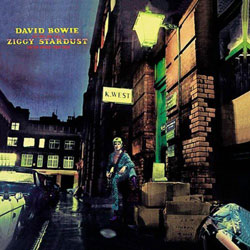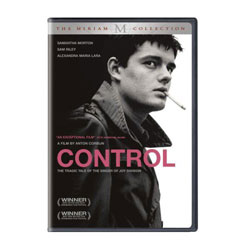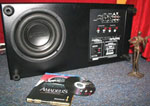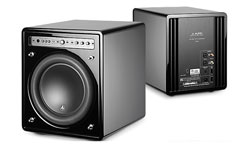Introduction
It would truly surprise me if anyone reading this review had not heard of JL Audio. Notwithstanding JL Audio’s stellar reputation in the car audio world, its Fathom and Gotham series of subwoofers have set the home audio/video world on fire like few products in recent memory. The F110 is both the most modest of the more modest Fathom series as well as its latest addition. As with the other models in the Fathom and Gotham series, the numerical nomenclature signifies both the quantity and size of the driver(s). Accordingly, “110” means one 10-inch driver.
Specifications
- Design: Sealed Enclosure
- Driver: One 10″
- Amplifier: 900 Watts RMS (Class D)
- MFR: 25 Hz – 111 Hz, – 3 dB
- Dimensions: 15.6″ H x 19.9″ W x 17.3″ D
- Weight: 67 Pounds
- MSRP: $2100 USA (Satin Black), $2200 USA (Gloss Black)
- JL Audio
Design
In the F110, that driver finds its home in a heavily-braced, sealed black or black gloss cabinet with luxuriously rounded corners and sitting sturdily on four ground-grabbing rubber feet. I’ve never been a fan of gloss black, so when given the choice, I didn’t hesitate in choosing the satin black. For an item in this price range though, it would be nice to have more cabinet finish choices. For example, I could see this subwoofer looking very cool in silver, similar to what Meridian and Wilson offer on their speakers. The included grille is easily removable and replaceable. If so inclined, you could even do this every day – my guess is that it would probably take a decent pair of pliers and plenty of rage to break off the metal pegs that attach the grille to the cabinet. The sense you get from the F110 is that it is indestructible. I preferred the look of the F110 with the grille off, so I kept it that way most of the time.
It is probably the appropriate time to reveal that I received not one, but two of these bad boys. Apparently, JL Audio is a firm believer in deploying subs in stereo and as manufacturers go, they are not alone in that view. I remember visiting Kevin Voecks’ (of Revel fame) home several years ago as part of a press event and he told me I really needed to think of subwoofers in pairs. I had never owned subwoofers, never auditioned them in my home, but thought to myself, ok, that’s easy enough to remember and simple enough to understand – front main left and right should each have a corresponding subwoofer.
Setup
I’m not going to waste precious time on how I unpacked the F110, or further description of its appearance, except to say that most of the many fine-tuning controls are located on the front panel, which I found very convenient. Also, as I’m not sure how many subwoofer manufacturers now include such a feature, it is worth mentioning that JL Audio includes in all its subwoofers an automatic setup program called “Automatic Room Optimization,” or “ARO,” which claims to flatten bass peaks caused by room modes. The ARO process requires you to set the front panel controls to certain positions and then, with the supplied microphone, sit in the primary listening position while the subwoofer cycles through a series of noise tests.
After several minutes, voilà, the subwoofer’s in-room response is supposedly optimized. Once the ARO has been completed, it is stored and can be engaged or disengaged via the front panel. I left the ARO engaged most of the time. As a final preliminary comment, I found that as a general matter, the F110 manual was quite good at what was a very unfamiliar process to me – it includes lots of pictures and lots of words, but all were easy to understand. As JL Audio advises, stereo subwoofers should be placed near the main speakers and the pair of F110s I received were placed just outside my Avalon NP 2.0 Evolutions; the back edges of the F110s were 5.25″ from the front wall while the outside edges were 10.25″ from the side walls. I connected the F110s to the pre-out of the different integrated amplifiers I had on hand. The front wall measures 172″ wide overall. The other dimensions of the room include a length of 246″ and a height of 117″.
In Use
It was sheer luck that the first CD I chose to play made it possible for me to write this entire section based on it alone. I’m not going to do that, but in no way should my choice to write about other music, movies, or video games diminish this first event as truly monumental. As an aside, I can’t remember the last time I characterized playing a CD at home in that way. In late 2007, M.I.A. released “Kala” and despite hearing it scores of times since then, I had no idea what it really sounded like until it exploded out of my unrecognizable, F110-endowed system.

If you have any doubt about the value of a subwoofer (or two), this CD will convince you that subwoofers are absolutely essential. As just one example, there is so much going on in track two, “Bird Flu,” that it is not surprising that in addition to two highly-resolving front speakers, I needed two incredible subwoofers to finally sort it all out.
This is the magic of these subwoofers and especially, the magic of two – they don’t blur the resolution or character of your main speakers at all, rather they add a tremendous amount of depth and substance to what you already thought was pretty good to begin with. In track one, “Bamboo Banga,” there is a male vocal track that doesn’t really integrate to the rest of the track if the subwoofers aren’t on. When they are engaged, however, it is astoundingly clear how important this vocal track is to the song as he urges M.I.A. over and over to “come on.” You think to yourself, well, maybe she wouldn’t continue without his encouragement, maybe she’d just stop singing.
I understand it may be difficult to understand this fully, so I will just say that not only had I never heard subwoofers enrich the stereo experience like this, I didn’t even know it could be done. My understanding was that, at most, a subwoofer might add a layer of bottom end to the presentation of the mains. I also believed that this was very difficult to make seamless. In years past, I sat for several of such demonstrations and was unimpressed as it was never seamless and it never sounded musical to me. I’m not talking ancient history either, this was as recently as a few years ago. I don’t know if JL Audio did this on their own, but folks, I’m here to announce that the world has changed.
M.I.A.’s music does yearn for subwoofers and very rarely is a listener, through a single CD, afforded the degree of insight into the night and day differences that subwoofers can make to a system, but what about music that does not rely so heavily (or at all) on gut-punching bass? Siouxsie and the Banshees have a compilation called “Once Upon a Time:

The Singles” and the album is comprised of tracks recorded from 1978-1981. Unsurprisingly, the production value is not terribly high, but the music is aggressive, raw, and original, so it really doesn’t matter to me. Track three, “The Staircase (Mystery),” is one of my favorites from the band and with the F110s firing away, the track’s hand claps inhabit a more distinct place on the stage in front of you. The bass is not anything you notice, rather, it is the imaging of your main speakers that now seems remarkable. Switch the subwoofers off and what happens? Everything sounds flatter, more compressed, less interesting. The effect is so miraculous that it’s not even fair to call the F110s subwoofers — it would be much more accurate to call them limited range, world-class speakers. While you ponder that, I’ll fast forward to track eight, “Israel.” Am I picking up what the F110s are laying down? You better believe it – the percussion on this track is subtle, lots of brush-on-cymbal goodness awash in backing, goth-vocal glory. I scrawl on the pad in front of me: “Whatever they cost, worth it.”
What was weird, at least to me, was that when arranging the review of the F110s, the possibility of reviewing one F110 was never discussed. Not that I generally object to being loaned expensive toys and of course, the more the merrier, but something began to bother me after a while and I figured out that it was my inability to make meaningful comparisons. I didn’t have a competitor’s subwoofer with which to compare, so my first comparison was the pair of F110s with a single F110. Surprisingly, the difference in output level did not seem as dramatic as I would have guessed. What did change, however, was that the single F110 called attention to itself in a way the pair never did. To hear what a single F110 sounded like, I generally turned off the left subwoofer and kept the right one on. As a result, the soundstage tilted a bit right. More importantly, however, a significant amount of soundstage width and depth that the pair created was noticeably missing now.
Playing the M.I.A. album, the single F110 sounded as if it was approaching its limits. While the output was still pretty jaw-dropping, there was a slight thumpy character to the sound. Needless to say, a single F110 did not integrate nearly as well as the pair. While I marveled (and maybe more so) at what even a single F110 could do and believe me, its athletic twists and turns through M.I.A.’s basslines was a feat to behold (imagine a rollercoaster cork-screwing backwards and you’ll get the idea), when a piece of equipment calls attention to itself, even if it is to be admired, it takes you away from the music. All of a sudden, the system felt unbalanced. You can rest assured, however, that even a single F110 will work and work and work, never tire, and never quit, until your power goes out.
If you do decide to go the only-child route and use a single subwoofer, the manual indicates that you will get smoother sound if you position it somewhere between the two front speakers as opposed to one of the corners. So you may be wondering why I didn’t do this for the single F110 in order to give it a fighting chance at integration. I’ll tell you. After a few months with the F110s and around the time I began to think about comparisons, I requested an F112. It certainly wasn’t my fault it came so quickly — at that point, you see, I had three subwoofers in my house and between the house-rattling experience of ARO and lifting the F112, the subwoofers were staying where they were.
There is some hackneyed expression about being careful what you wish for and, to my embarrassment, that fits the theme of the rest of this section better than anything else I can think of right now. To begin, I saw no point in comparing a single F110 to the F112. Instead, what interested me was the difference between the F112 and the pair of F110s. Maddening is how I would describe judging whether what I heard from one versus the other was objectively better. The F112 is clearly superior to the F110 – the output and the range simply overwhelms the smaller box. Put two of those smaller boxes together, however, and as the preceding paragraphs reveal, you have a considerable amount of magic-making at your disposal. While a single F112 can’t manage the disappearing act or the sound stage spreading feat of the F110 pair, comparing the respective charms, I found the F112 more musically satisfying overall as well as more adept at movie and video game presentation.
I don’t remember what the David Bowie albums sounded like before many of them were remastered in 1999, but they sound terrific now. While the main vocal can at times sound a bit pushed, everything else generally sounds terrific — nice wide sound stage and believably weighty instruments.

I have most of these remastered albums and so it was a conscious decision to play the heavily layered, “The Rise And Fall Of Ziggy Stardust And The Spiders From Mars.” Track three, “Moonage Daydream,” is one of my favorites, mainly for how all the different elements come together. I noted that the F112 was able to make the echoed vocal near the end of the track much more palpable than the pair of F110s. The F110s, on the other hand, better portrayed the hand claps on track four, “Starman,” locking their position in space and portraying a sound stage depth, which was superior to the effort of the single F112.
I did prefer the horns on “Rock ‘N’ Roll Suicide” and the percussion on “Five Years” through the F112 though, as both seemed imbibed with more texture with the larger subwoofer. Musically, the F112 just seems to have a lot more nuance to it – it’s as if you are sitting several rows closer to the stage and you can more easily discern, for example, the variations in force with which drums, piano keys, and cymbals are struck. More nuance would be exactly what I would expect from the greater frequency range of the F112. The much more powerful amplifier (1500 watt) probably helps as well.
At my “real” job, my workload is usually very unpredictable and this doesn’t really bother me except for the personal sacrifices I must make, for example, in finishing video games I have started. Indeed, it can be months between progress on a game and this is annoying chiefly because while I was in school, I often finished a game over the course of a week precisely because I could get away with staying up until 5 or 6 A.M every one of those nights if I so desired.

Last fall, I was very excited to get Left 4 Dead as this was THE big game of 2008 on XBOX 360. I had only played about an hour of it before the JL Audio invasion. The game is unique for its blend of kitsch and violence, but stylistic originality aside, above all else, it is about killing hundreds and hundreds of zombies. The constant barrage of guns is just one of the reasons the game is one of the most intense I’ve ever heard. The F112’s presence was felt immediately, adding an overall loudness and urgency to every sound, whether gunfire, zombie wail, or human scream. By comparison, the pair of F110s did not give me the same degree of sensory overload, but beyond that, I’m not sure I can say with absolute precision. What I will say is that I more often preferred the single F112. In the sake of full disclosure and out of fairness, I must mention at this point that JL Audio originally recommended a pair of F112s for my room, but as those had already been extensively reviewed in other magazines, I wanted to wait for the F110s.
My preference for the F112 was especially pronounced on DVDs. The scene from the “Dark Knight” in which Bruce Wayne test fires a few bullets into concrete was insane on the F112, whereas on the pair of F110s, it was merely spectacularly impressive. On both, the gunfire blanketed the entire room to the point at which “woah” will just sort of fall out of your mouth, but through the F112 there was something more — a realistic sense of bullets penetrating layers of concrete. Not confined to just sound effects, a similar sort of visceral impact was felt during the opening sequence of “Knocked Up,” featuring Ol’ Dirty Bastard’s “Shimmy Shimmy Ya.”
A film I particularly enjoyed last year was “Control,” which tells the story of Joy Division’s rise to fame in the late 1970s.

The soundtrack obviously kicks ass and while it is difficult to say anything critical of either the pair of F110s or the single F112, the F112 seems to add presence to the action on screen. The music-centric passages were often a draw, but not because they were identical – the F110s had the enormous sound stage thing going strong, while the F112 had an immediacy that made the film more involving even while it may have been technically less impressive-sounding. About half an hour into “Control,” the film portrays Joy Division’s television debut in England. The song is “Transmission,” and the lyrics go: “Dance! Dance! Dance! Dance! Dance to the radio!” There is an urgency and scale that the F112 is able to convey much more effortlessly than the pair of F110s although at other times during the film, I felt as if the F112 might be obscuring some of the natural detail of the mains.
Conclusions
Simply stated, I believe every system will improve with the addition of a subwoofer or two. As I discovered, you are really depriving yourself of a lot of music, not to mention the incredible amount of sonic information a subwoofer adds to the presentation of both movies and video games. The tougher call is whether you are better off with two smaller subwoofers or one larger one. Both solutions enrich, in an unprecedented way, almost every recorded sound you reproduce through your system, but which solution works best will likely depend heavily on your listening environment. Given that the combined expense of a pair of F110s is $4200, while a single F112 is $2800, the F112 is the easy choice on value for my particular room. Of course, all this really tells me is, sigh, that what I really need is a pair of F112s.
Associated Equipment:
Avalon NP Evolution 2.0, JL Audio F112, Lyngdorf SDAI-2175, Krell S-300i, Peachtree Audio Nova, Classe? CDP-10, Oppo DV-980H, XBOX 360, APC H15 Power Conditioner, Power and signal cables by Analysis Plus, Acoustic Zen, and Shunyata Research.



